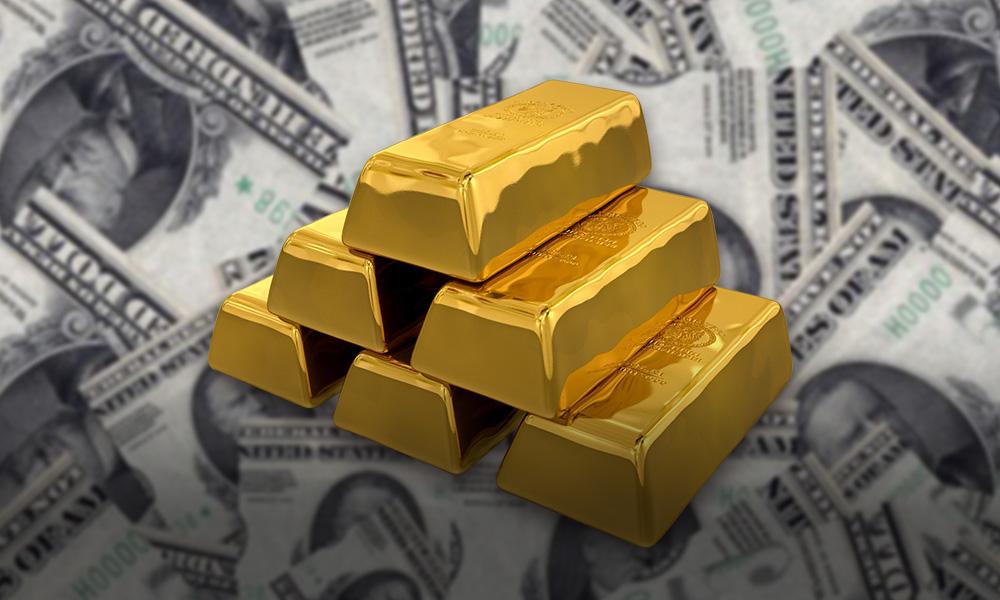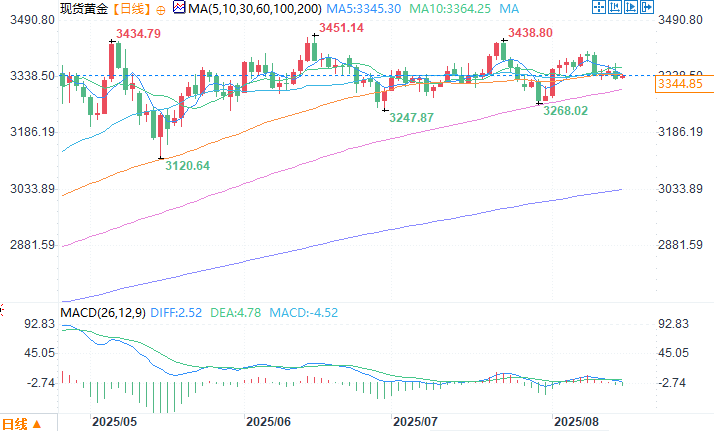The bigwigs discussed the various factors driving gold prices, saying that US debt is the most risky
2025-08-15 13:15:36
This week McIntyre discussed the various factors driving the gold market, some long-term and some near-term, and the impact each factor might have in the coming months.

Central bank demand is the cornerstone
The first long-term factor driving gold prices to record highs is central bank gold purchases, which have increased significantly since the outbreak of the Russia-Ukraine conflict.
McIntyre said central bank demand is still having a significant impact on the market, on the one hand providing bottom support for prices, and on the other hand sending signals to other market participants.
“I think it remains the cornerstone, just as it has been for the last three years,” he said.
But what has really changed over the past year or so is an increase in retail purchases. "To me, that's the narrative of increasing demand, primarily reflected in the amount of physical gold held in gold ETFs," he said. "After bottoming out in May of last year, we've seen growth for the first time in years."
Gold ETF holdings are rising
McIntyre noted that gold holdings are up about 11% year-to-date, but are still down about 17% from their peak in October 2020. "There's still a lot of room to run before gold ETF holdings reach all-time highs," he said. "But there's been a bit of a turnaround with institutional and retail investors, and that, to me, tells a whole new story."
The shift is global but also regional: Asian investors had been buying steadily for years, but the addition of European and then North American investors has turned global capital flows generally positive.
"Certainly, for me, I think it's really about the feeling that people are unsure," he said.
He said much of the world has been worried about the future for the past decade, if not longer, but not in the United States.
“They’re pretty comfortable with their existing holdings, the S&P 500 type of stocks,” he said. “I think for the first time in a while, they’re starting to reassess how much risk they’re taking and how much risk they’re willing to take.”
Americans are worried about inflation
McIntyre said that with the ongoing turmoil in the US government, he believes Americans are finally starting to question what safety net they have. “Gold obviously has a long history as a safe haven asset, and people have always been attracted to it,” he said. “I think it’s as simple as that.”
When asked about the possibility of "stagflation," a scenario in which the U.S. economy experiences low or negative growth while inflation rises, he suggested there could be two scenarios for inflation.
“I can argue it’s going to go higher, but I can also argue it’s going to go lower,” he said. “I don’t believe it one way or the other because of the economics, but I can certainly say from a currency devaluation perspective, you have to believe inflation is going to be stronger regardless of what the economy does or doesn’t do.”
McIntyre said the fiscal situation "in the United States in particular, but it applies to several other Western countries as well, is so different than it has been in a long time. The fact that we have a deficit of 7% of GDP and more than half of that is net interest related is a bit crazy."
Debt interest will inhibit economic growth
He said: "Here's how I think about it: Sprott's current forecast, and most people's, including the Congressional Budget Office (CBO), are basically forecasting nominal annual growth of about 4% for the U.S. economy. If interest is over 3% of GDP, it's basically consuming over three-quarters of economic growth. We're not far off the pace of actual consumer economic growth, just the interest, let alone the need for new borrowing, which is an absolutely terrifying view. Once you get to the point where interest basically overwhelms growth, to me that's a clear sign that the debt can't be repaid."
He added: "Not only that, it will accelerate the deterioration of the fiscal position, making payments almost impossible at that point. Even the CBO projects that net interest payments will exceed 4%, a higher than the alarming rate of growth it currently projects."
McIntyre said one of the biggest threats to the dollar's value is that the U.S. will have to print a lot of additional money to cover these deficits and ultimately repay the debt itself.
He added: "The government has taken on excessive extra spending relative to GDP. The government is now effectively subsidizing the economy and has been doing so since the crisis, so we have a deficit of between 6% and 7% and without government support it could easily be closer to 10%."
“ Sovereign risk is the most unpredictable element of this whole thing: When do people actually start pricing it into yields and everything else? That’s the biggest risk that’s coming, and in my opinion, it’s not far off, ” he said.
But while some of gold’s key drivers are relatively stable, incremental, and linear, others are much harder to predict. Chief among these are the two topics that have dominated financial market circles since Trump took office: trade tariffs and the independence of the Federal Reserve.
Markets ignore tariff talks
McIntyre acknowledged that gold’s recent rally to an all-time high of $3,500 an ounce occurred against a backdrop of extreme uncertainty about tariffs, but the market has since become somewhat immune to the administration’s statements and threats.
"I think people have become more comfortable with the announcements and the reality," he said. "It changes so frequently, and I just think people have lost sight of it to a certain extent, and whether that's right or wrong, I don't know, but it's hard to keep up with it in itself. There are so many tariffs, whether it's on specific products or products from different countries, and there's a lot of nuance."
He added: "Some of it is misinformation, some of it is true, and you get all sorts of different crosswinds. Even in the Trump administration, conflicts between different people were resolved within hours on social media. One person said one thing, and the other person had to correct or adjust it. I think people have become desensitized to a certain extent."
“From an investment perspective, particularly from our perspective of looking at commodities and precious metals, the only thing we know is that the more uncertainty there is, the better it is for gold,” he said. “It’s obviously been very bullish for gold prices and will continue to be. To me, the key is whether people can actually tolerate uncertainty about the investments they own. If you’re a gold investor, it’s neutral or positive, depending on what it is, but it’s probably not negative.”
Attacks on the Federal Reserve's independence
It is much harder to ignore Trump’s recent attacks on Fed Chairman Powell and the Federal Open Market Committee’s (FOMC) wait-and-see monetary policy because, unlike trade policy, they strike at the heart of the dollar’s credibility as a reserve currency, both domestically and internationally.
McIntyre said part of the problem is that markets are too focused on the Federal Reserve these days because they are desperate for a rate cut to save them.
“Right now, I would say more people are focused on the Fed and where interest rates might be going than on where the economy is going,” he said. “The only reason people care about the economy is how it affects interest rates because everyone, including the government, is so leveraged.”
“One of the scariest things for me was removing the guy from the Bureau of Labor Statistics last week because the labor data was theoretically manipulated, which is unlikely, of course,” he said. “But again, it erodes confidence in institutions. You never know when the psychology is going to change, but once it does, it’s very hard to reverse. You never want people to shift to that fearful mindset at the sovereign level because it’s very hard to reverse.”
Reasons to invest in gold
“That’s why I think ultimately, for people seeking a safe haven, all roads lead to gold,” McIntyre said. “Obviously, that doesn’t mean it should be their only asset, but we definitely think it should be at least 10% of people’s net worth. It’s a very small market, so to the extent that there are actually some large moves, particularly from the U.S., which tends to have lower participation in the gold market compared to other parts of the world, that could mean a big change in the price of gold.”
He added: "From an investment perspective, you have to look at this in terms of opportunity cost. If you make one investment, you obviously exclude yourself from making other investments, and if there are a lot of other good opportunities, it can be a difficult decision. But in my opinion, because there are so many extreme overvaluations, it is easy to turn to gold instead of other assets."

Spot gold daily chart Source: Yihuitong
At 13:14 Beijing time on August 15, spot gold was quoted at $3345.85 per ounce.
- Risk Warning and Disclaimer
- The market involves risk, and trading may not be suitable for all investors. This article is for reference only and does not constitute personal investment advice, nor does it take into account certain users’ specific investment objectives, financial situation, or other needs. Any investment decisions made based on this information are at your own risk.





















